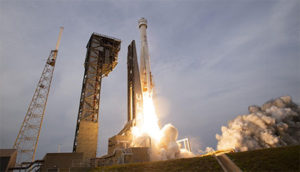AIAA Statement on Successful Orbital Flight Test-2 (OFT-2) Mission
FOR IMMEDIATE RELEASE

A ULA Atlas V rocket with Boeing’s CST-100 Starliner spacecraft aboard launches from Space Launch Complex 41, Thursday, 19 May 2022, at Cape Canaveral Space Force Station in Florida. | Credit: Joel Kowsky; NASA
May 21, 2022 – Reston, Va. – The American Institute of Aeronautics and Astronautics (AIAA) Executive Director Dan Dumbacher made the following statement:
“Congratulations to the NASA and Boeing team on the successful Orbital Flight Test-2 (OFT-2) mission, including the beautiful launch of the Starliner spacecraft atop a United Launch Alliance Atlas V rocket. We applaud their combined efforts to deliver this uncrewed cargo mission to the International Space Station (ISS).
The OFT-2 mission is a major step on the path to further realize the potential of NASA’s Commercial Crew Program to safely and reliably fly humans to and from low Earth orbit (LEO). We are encouraged to see human spaceflight capability to the ISS from the United States increase, as the aerospace industry continues opening access to space for more people as part of building the space economy.
New spacecraft programs like Starliner rely on a highly qualified team of partners. We recognize the countless AIAA members involved in all aspects of the supply chain in this endeavor, including those who have helped design, build, and test this new spacecraft. We salute everyone involved for their important contributions to this much needed new capability.”
Video
Boeing Starliner Launches to the International Space Station on Atlas V (Boeing via YouTube)
Media Contact: Rebecca B. Gray, RebeccaG@AIAA.org, 804-397-5270 cell
About AIAA
The American Institute of Aeronautics and Astronautics (AIAA) is the world’s largest aerospace technical society. With nearly 30,000 individual members from 91 countries, and 100 corporate members, AIAA brings together industry, academia, and government to advance engineering and science in aviation, space, and defense. For more information, visit www.aiaa.org, or follow AIAA on Twitter, Facebook, or LinkedIn.
Banner image at top of page: A ULA Atlas V rocket with Boeing’s CST-100 Starliner spacecraft aboard launches from Space Launch Complex 41, Thursday, 19 May 2022, at Cape Canaveral Space Force Station in Florida. | Credit: Joel Kowsky; NASA




